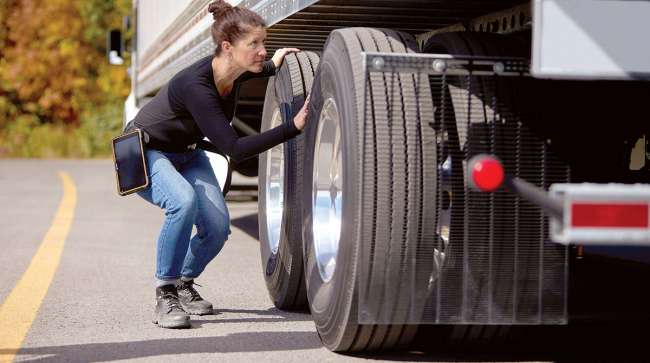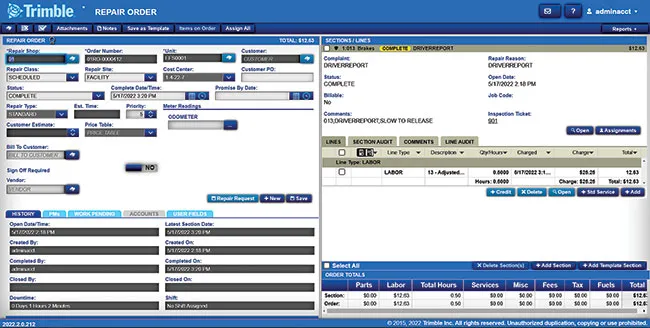Fleets Find Advantages With Electronic DVIRs

[Stay on top of transportation news: Get TTNews in your inbox.]
Driver Vehicle Inspection Reports help fleets identify vehicle defects, prevent downtime, avoid roadside violations and improve safety, but the manual DVIR process can create operational challenges. Drivers may rush through the process, paperwork can get lost or there can be transmission delays. With such disruptions, fleets are turning to electronic DVIRs to streamline inspection and repair processes, making it less demanding on drivers and increasing efficiency.
Kriska Holdings Ltd. uses technology from Isaac Instruments. “It is a tool that makes your driver’s day so much easier,” said Guy Broderick, safety and training supervisor for the Prescott, Ontario-based fleet.
Drivers receive a step-by-step inspection checklist via a tablet, document each inspection point and take pictures of any issues. “The inspection is probably more thorough in the same amount of time,” said Melanie Simard, director of compliance, client services and technical support for Isaac Instruments.
Suyog Deshpande, head of product and partner marketing at Samsara, said manual and paper processes are time-consuming and less accurate. However, digitizing the vehicle inspection process can free up time and resources, eliminate unnecessary paperwork and streamline maintenance.
Getting drivers to take the time to do a DVIR and document any issues is one of the biggest challenges associated with DVIRs, said Florence Dougherty, director of product management, fleet solutions — compliance and driver experience for Solera. “Drivers are often paid by the mile, so anything that takes away from the time they are moving down the road eats into their pay,” she said. “Streamlining and improving the inspection process helps ensure drivers are not just glossing over the inspection in order to get on the road or skipping it altogether in the interest of time.”
Automation decreases the driver’s interaction with the system, allowing them to focus on driving. “It also eliminates inaccuracies in the data, promoting better downstream processes such as repair management,” said Sherif Nasr, business area manager, fleet mobility at Trimble Transportation.

With Trimble, DVIRs with defects can automatically trigger a work order in TMT Fleet Maintenance, driving a workflow in the shop. (Trimble Transportation)
Bryant Maxey, product manager for Zonar’s eVIR (electronic VIR), said the technology can even reduce drivers’ inspection times while ensuring drivers move around the vehicle. “Where paper inspections fail is drivers can sit in the cab and pencil whip everything,” he said, adding that Zonar utilizes RFID or NFC tags placed along the tractor and trailer that drivers scan to demonstrate they’ve covered all the inspections points.
More importantly, taking time to inspect equipment can increase driving time. “It is the low-hanging fruit — a headlight out or a chipped mudflap — that can get drivers pulled over, and then the inspector can do a 21-point inspection,” Maxey said. “If the vehicle or driver is placed out of service, nobody is getting paid, and the customer isn’t served.”
Customization
In addition to standard items covered during a pre- and post-trip inspection, fleets can customize the inspection reports based on the fleet, driver group or type of equipment with the right technology. “FMCSA might not care about the oil in the engine, but I do as a fleet because it is important for my vehicle’s life,” Simard said. “I could assign my cross-border truck a specific inspection and a city truck a different inspection. It depends on how granular you want to get.”
Fleets can also make seasonal adjustments.
“I’ve seen winterized lists—’Did you check fuel additives?; Did you purge your air tanks?’ ” Simard said. “It is customizable and interchangeable depending on the ops of the fleet.”

Simard
With paper DVIRs, there can be challenges getting those documents back from drivers in a timely manner, but electronic information is transmitted in real-time, allowing fleets to become proactive instead of reactive.
At Kriska, drivers’ reports are sent to 26 people within the fleet, safety and customer service departments. “Usually, the first to respond are people from fleet, but the second person is the customer service manager. It is so easy to keep everybody in the loop,” Broderick said, adding that nonurgent repairs are scheduled for a convenient time, and urgent repairs are addressed 24 hours a day.
DHL, which uses electronic DVIR technology from Samsara, created a workflow so immediate alerts go to fleet managers and mechanics for unsafe items. “They can log in right away and see the notes from the driver and see the issue,” said Fred Matthews, senior manager of safety for DHL, which is based in Cincinnati. “Not only are they not chasing paper logs, but they have it in real-time, so all three of them can be looking at the same thing at the same time. It speeds up what they need to do for the resolution.”
Samsara’s Deshpande said some customers have achieved a 40% quicker response on maintenance issues since utilizing electronic DVIRs.
With Trimble, DVIRs with defects can automatically trigger a work order in TMT Fleet Maintenance, driving a workflow in the shop. “Once the defect is corrected, the driver is specifically prompted, in-cab, to confirm that the defect was indeed repaired and that the vehicle is deemed ‘safe to operate,’” Nasr said.
Zonar integrates with all fleet maintenance platforms, enabling the maintenance shop to prioritize the most critical repairs rather than sifting through paper documents one by one. The system also pre-populates defects on DVIRs if they haven’t been cleared out on the back end. “That helps maintenance out because it decreases the number of work orders,” Maxey said.
The ability to add photos can increase clarity and efficiency, reducing the time a driver spends trying to describe an issue, Dougherty said.
Want more news? Listen to today's daily briefing above or go here for more info
With supply chain delays, having photos allows fleets to ensure the needed parts are in stock and ready to go when the equipment arrives. “If a driver can take a picture and send it off, then we know exactly what part it is. They can pre-order that part, so by the time the driver shows up at the dealership, they can have it,” Broderick said.
Improving Safety
When defects are transmitted and addressed quickly, fleets reduce the risk of a roadside breakdown or violation, which can be costly to fleets, especially if the vehicle is placed out of service. “If you have a minor defect and they’re reporting right away, it won’t turn into a huge breakdown,” Simard said.
In 2016, the Federal Motor Carrier Safety Administration stated that roadside inspections prevented 14,000 accidents and 9,000 injuries, Nasr explained. “Ensuring that vehicles are safe to operate at the beginning, during, and at the end of each workday will naturally improve public safety and prevent crashes,” he said.
Fewer violations, increased uptime and the prevention of more significant problems all contribute to fleets’ return on investment. “A tire can cost $400 for one. If you’re not seeing that tire pressure is low, you’re going to end up paying for that,” Maxey said.
Addressing problems sooner can also decrease legal exposure and liability. “The real ROI is realized when fleets have practically eliminated all at-fault crashes, thus improving their CSA score, and all downtime and/or out-of-service time during operations,” Nasr said.
Plus, strong safety scores are essential for insurance renewal and business. “A customer will use a certain fleet because of their safety rating. When you see all kinds of maintenance failures, you don’t want to put your freight in their trailer,” Simard said. “Even drivers don’t want to drive for a company that doesn’t maintain their fleet. They know they’ll be down and won’t be making money.”
Avoiding more extensive repairs also impacts driver satisfaction. “You don’t want to lose them because of delays,” Simard said, adding that electronic tools can empower drivers and encourage DVIR compliance. “When drivers feel that they’re being heard and what they are doing has a positive outcome, they’re more inclined to do it.”
Drivers can also use the reports to ensure they don’t get blamed for damage that was already there. “It creates an electronic paper trail,” Broderick said.

Broderick
Matthews agreed, noting that it’s best for a driver to make sure their information is correct. . “If there is a scratch, drivers will add it to their DVIR,” he said. “They want to make sure we know they didn’t do it.”
Managing Information
Electronic systems can also improve recordkeeping. DOT requires fleets to keep 90 days of inspection on file. “It can eat up a lot of time quickly looking through filing cabinets,” Matthews said.
Broderick said it is easy for drivers to share information with inspectors. “A driver had a full Level 2 inspection, and everything passed with flying colors. He was able to show the officer all of his paperwork, inspections and logs,” Broderick said.
In the event of an accident, fleets need to create a file that includes past inspections and driver logs. “When building it, it is ‘click, click, click,’ ” Broderick said describing the ease of process. “Can you imagine if you didn’t have access to having that digitized?”
While there are several benefits to electronic DVIRs, Matthews said the technology is only helpful if it is simple. “There are a lot of apps and a lot of companies that do electronic DVIRs, but if it isn’t quick and easy for the drivers, they aren’t going to use it,” he said. “It has to be user-friendly.”



